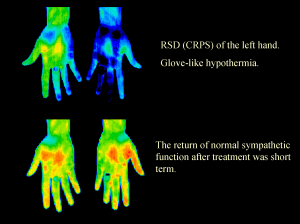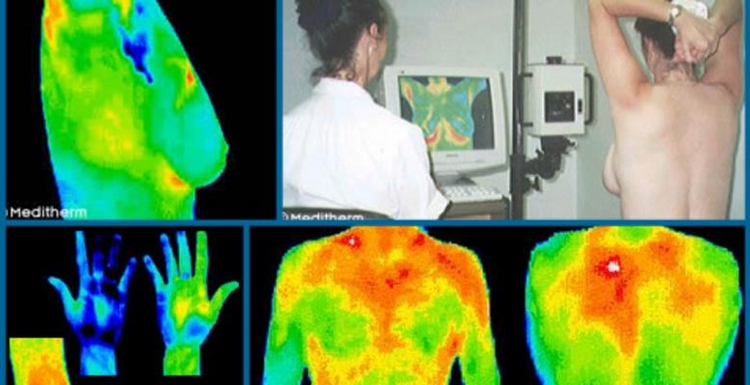These thermal images (called thermograms) are analyzed for abnormalities that may be signs of disease in your body. Additionally, since your body is thermally symmetrical if normal, thermal asymmetries can indicate problems.
Measuring inflammation through thermal imaging is a proactive method you can use for detecting disease, which will significantly improve your chances for good health and longevity.
Thermograms provide :
- Reliable and accurate information
- Considerable financial savings over other screening/imaging options…
Thermograms are:
- Not painful…
- Non-invasive…
Thermograms:
- Makes no contact with your body – no compression
- Emits absolutely NO radiation
- Currently remain as the only method available for visualizing your pain and pathology…
- Can assess pain and pathology anywhere in your body….
- are a very useful adjunctive procedure to other diagnostic tools, such as x-ray and ultrasound…
- are very cost effective, risk free, and provide you with instant images…
While x-rays, CT scans, ultrasound, and MRI scans are all tests of “anatomy” that measure structures of your body, thermography is unique in its ability to measure your physiological changes.
Some who are misinformed view mammograms and thermograms as competitors. I can assure you that is not the case and not at all how we feel here at Gaston Thermal Imaging, Inc.! Each breast imaging option that is available to us detects different characteristics within the breast tissue. We consider them complimentary to each other and not competitors at all. We feel it is important for the patient to be familiar with the risks and benefits as well as the strengths and weaknesses of each test.
Here is a short overview of each technology:
Thermography is a physiological test that can be utilized for all breast types and has no risks associated with it. It detects increased blood flow related to cancer and other conditions but cannot pinpoint the exact location of pathology or see inside the body. Possibly the most important reason to utilize thermography would be its ability to detect abnormalities in breast tissue years before other imaging techniques.
Mammograms utilize x-ray technology (radiation) and compression in order to detect dense objects within the breast tissue. The risk of radiation used in mammography is controversial due to the negative impact it can have on the patient. In some studies it has been shown to increase a women’s risk of breast cancer. It is most effective for imaging fatty breasts. Mammograms are not effective in monitoring dense breast tissue. When a mammogram detects an abnormality such as a tumor it may have been growing for 6-10 years before it was big enough for the x-ray technology to see.
Ultrasound is another test for imaging breast tissue which uses sound waves that also need a dense object to bounce off of in order for detection. There is very little risk involved in this screening method, however it is better at screening dense breasts than fatty breasts. Ultrasound is helpful in determining if a lump detected is a fluid filled cyst or a solid mass that may be a cancerous tumor.
MRI is a very sensitive imaging option we have all heard of. MRI is very expensive and because of that is usually only recommended after another technology has discovered an abnormality. It can fail to detect some cancers and also produce false positives because it is so sensitive.
So to take another look at all four technologies it is clear to see that thermography is a physiological screening tool that is focused on risk assessment and disease development. It helps those of us that wish to be proactive about our breast health have a chance to make diet and lifestyle changes before our health gets out of control. MRI, Ultrasound, and Mammography are focused on detecting existing disease. None of the imaging options actually diagnose disease. Further clinical evaluation is always necessary. A biopsy is the only way to confirm a cancer diagnosis. Thermography is a powerful adjunctive screening tool increasing the accuracy of our other imaging options. It can help assist by providing a thermo-vascular map that indicates the physiological process that can be compared to the structural change or stability.
What else can thermography detect in your body?
Early stage disease detection is another area in which thermography excels
Thermography screenings can assess heart function and detect inflammation in the carotid arteries (which may be a precursor to stroke and blood clots). When inflammation and/or occlusion of the carotid is visible, your doctor may do additional testing. Earlier detection of a heart problem may save your life.
And here are some other examples:
- Arthritis: Thermography can help you detect early signs of arthritis — and differentiate between osteoarthritis and more severe forms like rheumatoid. Effective early treatment strategies can then be implemented, before you experience further degeneration.
- Neck and Back Pain: Thermal pain patterns ‘light up’ white and red hot on a scan in the involved area. You can get relief faster and begin restorative care that more precisely targets the correct area.
- Dental Issues: If you have TMJ, gum disease, or an infected tooth, this will show up on a thermal scan as white or red hot.
- Sinus Issues & Headaches: Significant heat in your forehead or sinus region revealed on a thermal scan is an indicator that these systems in your body are not functioning properly.
- Immune Dysfunction, Fibromyalgia and Chronic Fatigue: The immune system correlates to the T1 andT2 areas of your spine — high levels of heat in that region can indicate immune dysfunction. On the other hand, chronic fatigue, fibromyalgia, and aching joints are just a few complaints that correlate to cool patterns seen at this area.
- Carpal Tunnel Syndrome (CTS): This condition is often misdiagnosed. For instance, you may think you have CTS, yet the scan shows your neck is referring pain from a different affected area. This will help you get the most appropriate treatment.
- Digestive Disorders: Irritable bowel syndrome, diverticulitis and Crohn’s disease are often visible with thermography. If you’re able to address these conditions early on, you’ll find that health restoration is much more likely.
- Other Conditions: Including bursitis, herniated discs, ligament or muscle tear, lupus, nerve problems, whiplash, stroke screening, cancer, and many, many others.
With all the great benefits of thermography, it may sound complicated — but it’s not!
Call today for your appointment and speak to one of our certified thermographers. Our office is physician owned and we are committed to providing exceptional service by using the best equipment available. We strive to provide a safe, comfortable environment with well trained technicians and access to educated healthcare professionals for each of our valued clients (704)853-9160.

